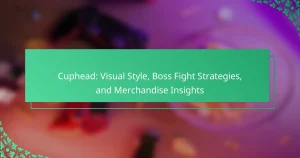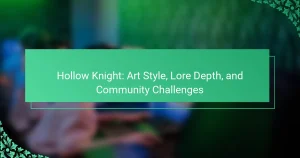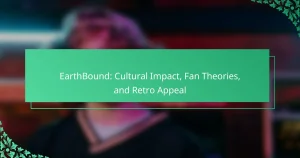Shovel Knight offers a unique blend of retro aesthetics and modern gameplay mechanics that captivates players. This article explores the game’s core design principles, character inspirations drawn from classic platformers, and the vibrant fan art community that enhances its appeal. Additionally, it examines how the narrative structure and gameplay mechanics intertwine to create an engaging player experience.
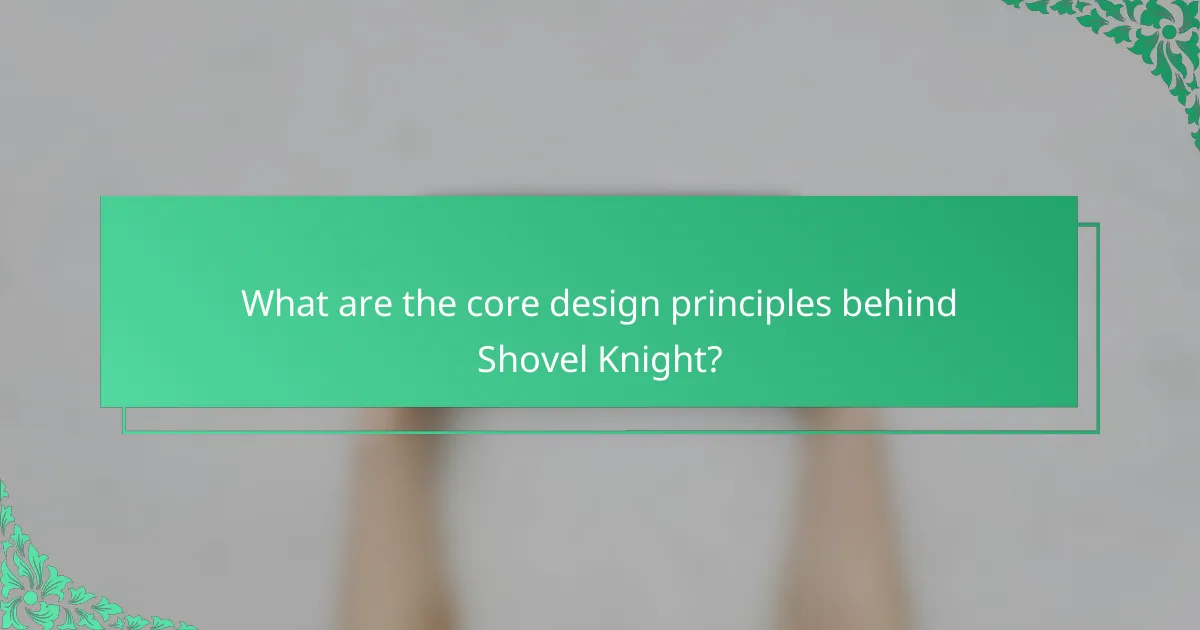
What are the core design principles behind Shovel Knight?
Shovel Knight’s core design principles focus on retro aesthetics, tight controls, and engaging gameplay. The game emphasizes nostalgic elements while incorporating modern mechanics that enhance player experience. Its character designs draw inspiration from classic platformers, blending unique traits with memorable visuals. The balance between challenge and accessibility is a key attribute, ensuring players remain engaged without feeling overwhelmed. Additionally, Shovel Knight fosters community creativity through fan art, showcasing the game’s influence on its audience.
How does pixel art influence gameplay experience?
Pixel art enhances gameplay experience by creating a nostalgic and immersive atmosphere. Its distinct aesthetic influences player engagement and emotional connection. The vibrant colors and pixelated designs evoke memories of classic games, fostering a sense of familiarity. Shovel Knight leverages this style to enrich its character design and world-building, making gameplay more visually appealing and memorable. The simplicity of pixel art allows for clear communication of gameplay mechanics, enhancing player understanding and interaction.
Why is level design crucial in Shovel Knight?
Level design is crucial in Shovel Knight because it shapes gameplay experience and player engagement. Thoughtfully crafted levels enhance exploration, challenge, and the overall narrative. Each stage introduces unique mechanics and enemies, ensuring varied gameplay. The design also encourages mastery of skills, making player progression rewarding. Additionally, the integration of platforming elements and secrets fosters a sense of discovery, vital for player retention and enjoyment.
Which mechanics enhance player engagement?
Shovel Knight enhances player engagement through nostalgia, challenging gameplay, and character development. Nostalgia connects players to classic platformers, while challenging gameplay fosters a sense of achievement. Character development, including unique abilities and backstories, deepens player investment in the game.
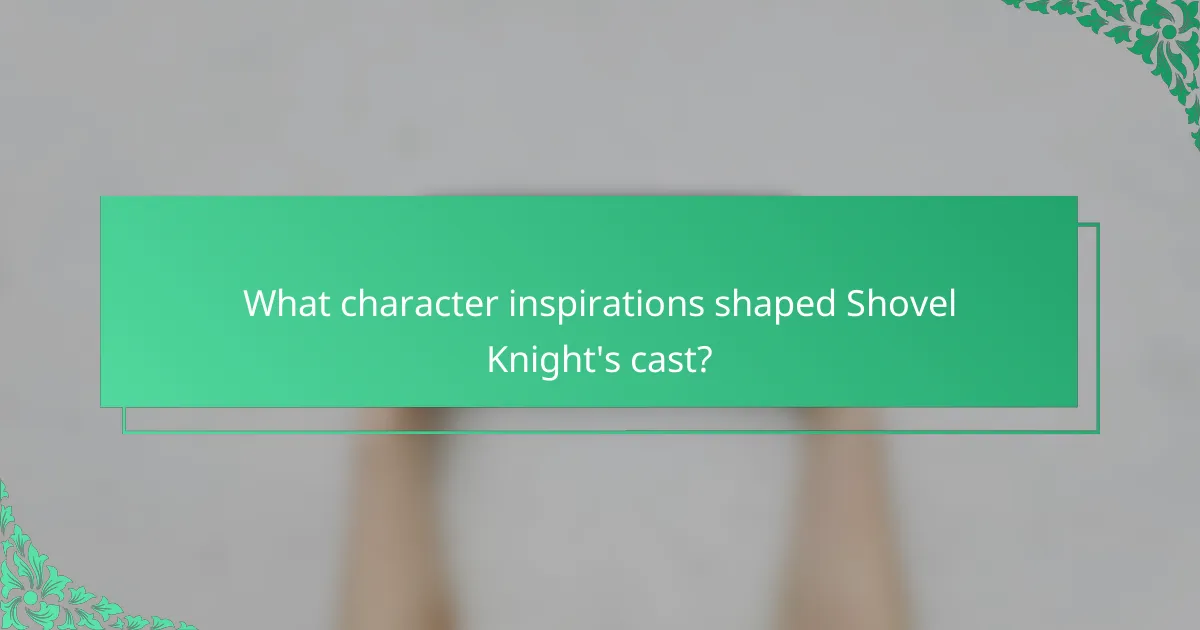
What character inspirations shaped Shovel Knight’s cast?
Shovel Knight’s cast is inspired by various classic video game characters and archetypes. The developers drew heavily from 8-bit and 16-bit aesthetics, creating characters that evoke nostalgia. For instance, Shovel Knight resembles the knightly heroes of old, while enemies like the Enchantress reflect magical villains from iconic games. Unique attributes include the character designs that blend humor and heroism, setting them apart in modern gaming. Rare inspirations come from lesser-known titles, enriching the game’s lore and depth.
How do classic video game heroes influence character design?
Classic video game heroes significantly impact character design by inspiring visual aesthetics and gameplay mechanics. Shovel Knight draws from retro influences, merging nostalgia with modern design principles. This fusion creates a unique character that resonates with players. Iconic heroes like Mega Man and Link serve as foundational inspirations, shaping Shovel Knight’s abilities and appearance. Additionally, fan art showcases diverse interpretations, reflecting the character’s broad appeal and influence on contemporary design trends.
Which historical figures inspired specific characters?
Shovel Knight’s characters draw inspiration from various historical figures. For instance, the character Shield Knight embodies the chivalric ideals of knights from medieval history. Specter Knight reflects themes of death and the afterlife, reminiscent of figures like the Grim Reaper. Plague Knight showcases characteristics of alchemists, emphasizing the blend of science and mysticism. These inspirations enhance the game’s narrative depth and character development.
What cultural references are embedded in character backstories?
Cultural references in character backstories of Shovel Knight draw from various influences, including folklore, classic literature, and gaming history. Characters like Shovel Knight and Shield Knight embody chivalric themes reminiscent of Arthurian legends. The inclusion of enemies like the Enchantress and the Order of No Quarter reflects archetypes from fairy tales and classic RPGs. These references enrich the narrative, creating a familiar yet unique world that resonates with players.
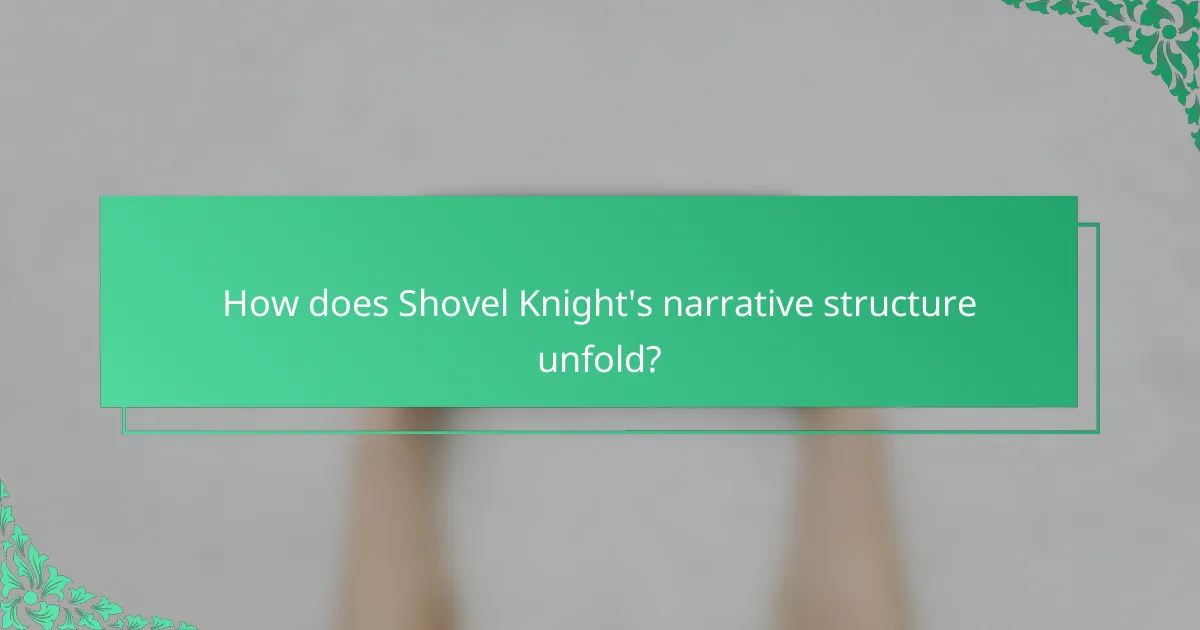
How does Shovel Knight’s narrative structure unfold?
Shovel Knight’s narrative structure unfolds through a classic hero’s journey, where the protagonist embarks on a quest to rescue his beloved. The story is framed by the conflict against the Order of No Quarter, each knight representing a unique challenge and character development opportunity.
As players progress, they encounter various environments that reflect the narrative’s emotional tone, from the dark and foreboding to vibrant and whimsical. The game’s dialogue and interactions deepen the lore, revealing backstories and motivations of both allies and foes, thus enriching the player’s experience.
Moreover, the narrative is interwoven with gameplay mechanics, where defeating each knight not only advances the plot but also unlocks new abilities and items, creating a seamless connection between story and action. This structure enhances player engagement and investment in Shovel Knight’s world.
What role does humor play in storytelling?
Humor enhances storytelling by engaging players and enriching characters in “Shovel Knight.” It fosters emotional connections and adds depth to gameplay. The game’s witty dialogue and playful references create a memorable experience. This unique approach contributes to its charm and appeal in the gaming community.
How are player choices integrated into the narrative?
Player choices are seamlessly integrated into Shovel Knight’s narrative through branching paths and character interactions. These choices impact gameplay, altering story outcomes and character relationships. For example, players can choose to spare or defeat certain characters, leading to different narrative experiences. This design enhances player agency, making each playthrough unique and engaging. The game’s retro style complements its narrative depth, allowing players to feel a personal connection to their choices.
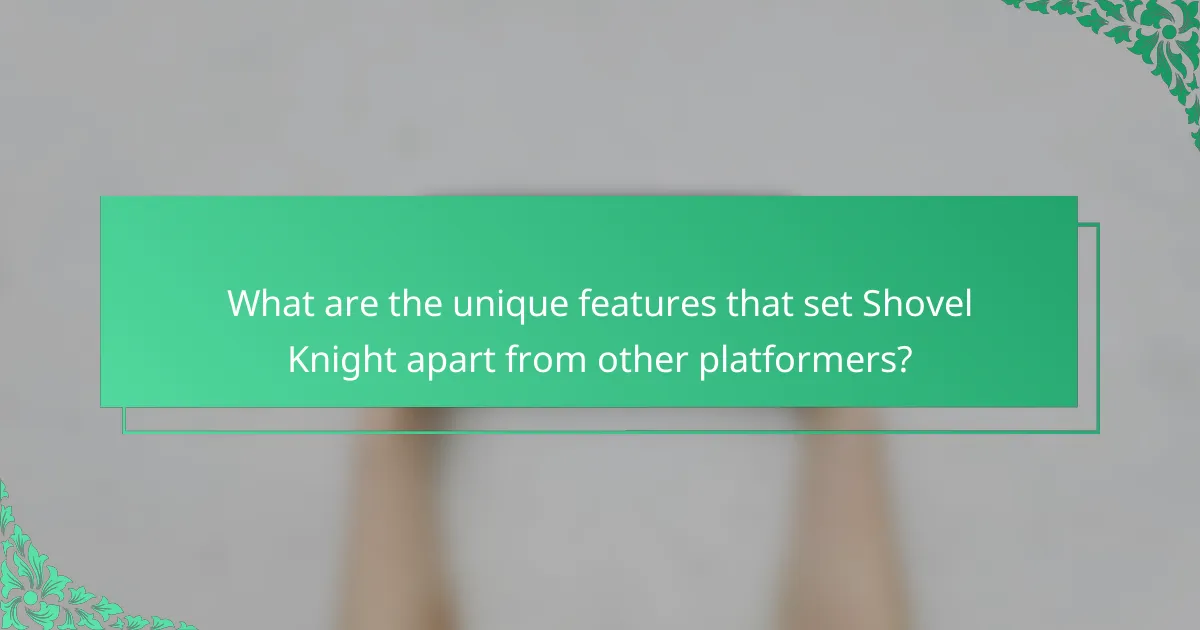
What are the unique features that set Shovel Knight apart from other platformers?
Shovel Knight stands out due to its retro-inspired design, engaging gameplay mechanics, and rich character development. Unique features include a blend of classic platforming with modern design elements, a compelling narrative that pays homage to past games, and memorable boss characters, each with distinct abilities. The game also features a unique art style that combines pixel art with fluid animations, creating a visually appealing experience. Additionally, its strong community presence and fan art further enhance its appeal, fostering a dedicated player base.
Which gameplay elements are considered innovative?
Shovel Knight introduces several innovative gameplay elements that enhance the platforming experience. Its unique mechanic of “shovel dropping” allows players to attack enemies and break blocks, blending combat and exploration seamlessly. The game features a retro-inspired art style that pays homage to classic 8-bit games while incorporating modern design sensibilities. Additionally, the use of a checkpoint system encourages exploration without severe penalties, making it accessible to a wider audience. The character design draws inspiration from various sources, enriching the narrative and gameplay diversity.
How does the music contribute to the overall atmosphere?
Music significantly enhances the atmosphere in “Shovel Knight” by complementing its retro aesthetic and emotional storytelling. The chiptune soundtrack evokes nostalgia, aligning with the game’s pixel art style. Each level features unique compositions that reflect the environment and challenges, creating an immersive experience. For example, the upbeat music during boss battles intensifies the excitement and urgency, while softer melodies in exploration areas foster a sense of adventure and discovery. This carefully crafted audio landscape reinforces the game’s themes and emotional impact, making music a vital component of its overall atmosphere.
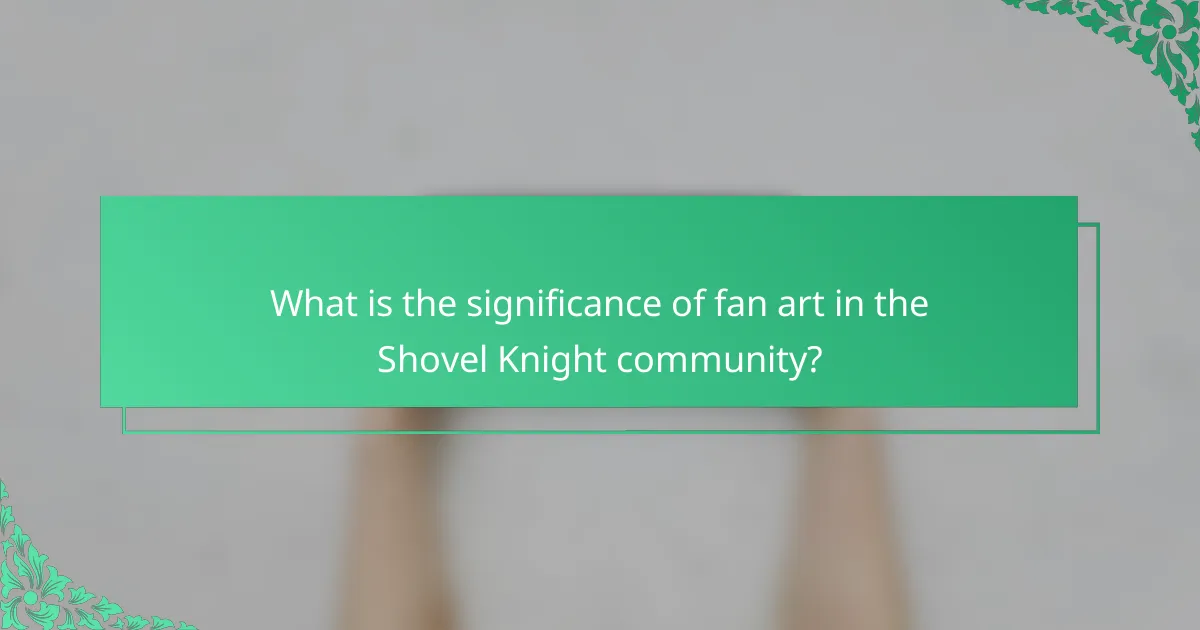
What is the significance of fan art in the Shovel Knight community?
Fan art holds significant value in the Shovel Knight community as it fosters creativity and engagement among fans. It allows players to express their passion for the game and its characters, enhancing the sense of belonging. Unique interpretations of characters showcase individual artistic styles, enriching the community’s diversity. Additionally, fan art often inspires official content, demonstrating the influence of the community on game development. This symbiotic relationship strengthens the bond between fans and creators, making fan art an integral part of the Shovel Knight experience.
How does fan art reflect community engagement?
Fan art reflects community engagement by allowing fans to express their creativity and connect over shared interests. It fosters collaboration and dialogue among players, enhancing the sense of belonging within the Shovel Knight community. This engagement is evident in the diverse interpretations of characters and game elements, showcasing unique artistic styles and perspectives. Fan art also serves as a medium for feedback, influencing game design and character development through community input.
Which themes are most commonly explored in fan creations?
Fan creations commonly explore themes of nostalgia, character backstories, gameplay mechanics, and artistic interpretations. Fans often draw inspiration from the retro aesthetic and gameplay style of Shovel Knight. They create fan art that highlights beloved characters, such as Shovel Knight and his rivals. Additionally, fan narratives may expand on the game’s lore, offering new perspectives on character motivations and relationships. This engagement showcases the community’s creativity and deep connection to the game’s design and storytelling elements.
What are the best platforms for sharing Shovel Knight fan art?
The best platforms for sharing Shovel Knight fan art include DeviantArt, ArtStation, and Instagram. These platforms cater to artists and fans, providing visibility and community engagement. DeviantArt offers a dedicated space for fan art, while ArtStation showcases professional portfolios. Instagram allows for quick sharing and interaction with followers. Each platform has unique features that enhance the fan art experience.
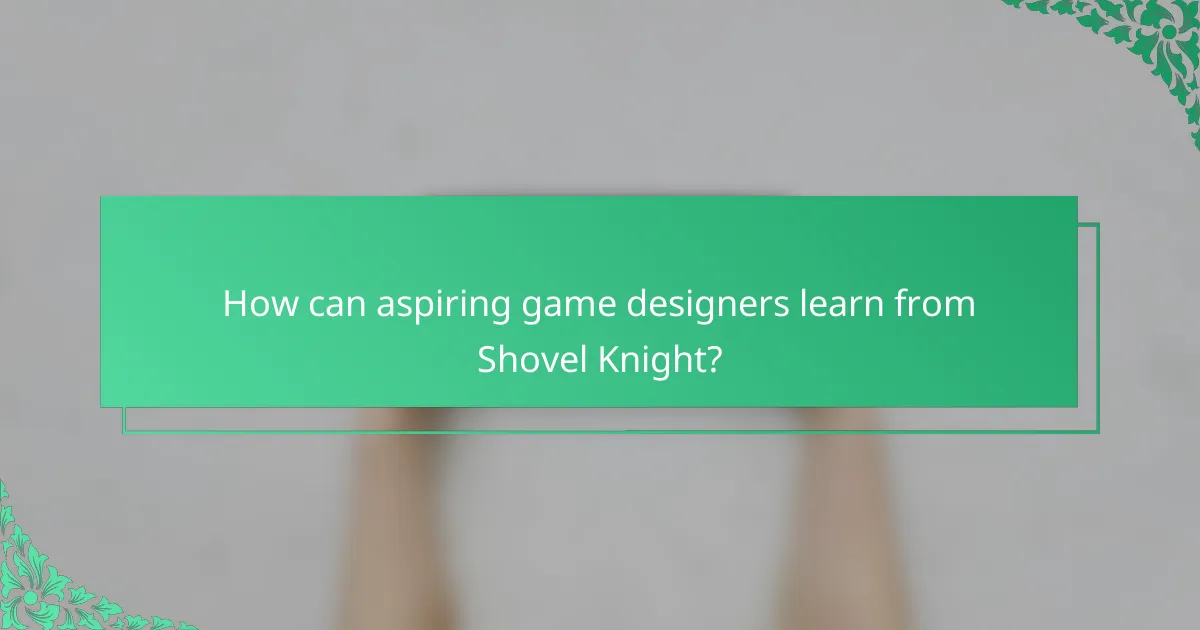
How can aspiring game designers learn from Shovel Knight?
Aspiring game designers can learn from Shovel Knight by analyzing its design principles, character development, and community engagement. The game showcases a blend of nostalgia and innovation, emphasizing pixel art, tight controls, and engaging gameplay.
Studying Shovel Knight’s character inspirations reveals how archetypes can be effectively reimagined. The game’s protagonists and antagonists draw from classic gaming history, providing a rich context for character design.
Fan art surrounding Shovel Knight illustrates community involvement and the impact of player creativity. Engaging with this art can inspire designers to understand audience interpretation and expression.
Overall, Shovel Knight serves as a case study in merging classic design elements with modern gameplay mechanics, fostering a deep connection with players.
What lessons can be drawn from its development process?
The development process of Shovel Knight teaches valuable lessons about game design, creativity, and community engagement. Emphasizing a blend of retro aesthetics and modern mechanics, the team prioritized player experience. They showed the importance of iterative design, adjusting gameplay based on feedback. Engaging with fans through art contests helped foster a strong community, demonstrating the impact of collaboration. Lastly, leveraging nostalgia while innovating ensured that Shovel Knight resonated with both old and new audiences, highlighting the balance between homage and originality.
Which design techniques can be applied to new projects?
Design techniques for new projects include pixel art, level design, character development, and narrative integration. These techniques enhance gameplay and player engagement.
Pixel art creates a nostalgic visual style that resonates with players. Level design involves crafting challenging environments that encourage exploration and mastery. Character development focuses on unique abilities and backstories that enrich player connection. Narrative integration weaves story elements into gameplay, enhancing immersion.
What common mistakes should be avoided in game design?
To avoid common mistakes in game design, focus on clarity, balance, and player engagement. A frequent error is neglecting player feedback, which can lead to unresponsive gameplay. Another mistake is poor pacing, causing player frustration or boredom. Additionally, overcomplicating mechanics can alienate players, while inconsistent art styles may disrupt immersion. Lastly, failing to prototype can result in untested ideas that don’t resonate with the audience.
